1425
Views & Citations425
Likes & Shares
Keywords: Visitor motivation, Visitor satisfaction, Sports tourism events, Malaysia
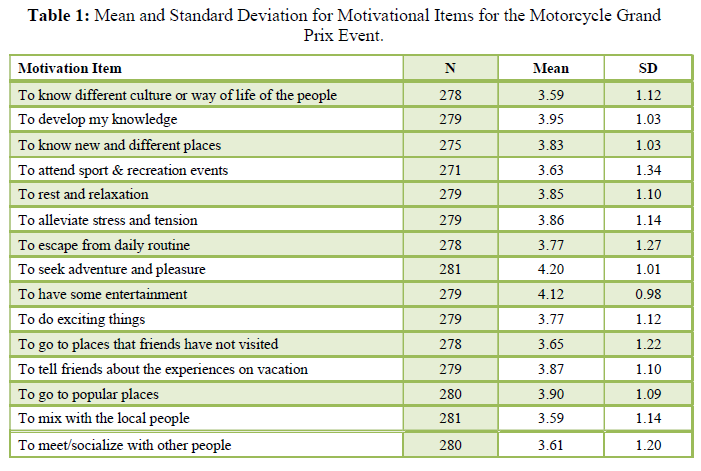
As shown in Table 1, all event participation motives scored above 3 in a 5-point scale (with 5.0 being extremely important), indicating that these attributes were deemed important to the respondents participating in the Malaysia Motorcycle Grand Prix event. Based on the fifteen motivational items extracted from the questionnaire, the motivational items examined indicated that the most important motivation for participating the event was to seek adventure and pleasure (M = 4.20), followed by ‘to have some entertainment’ (M = 4.12), and ‘to develop knowledge’ (M = 3.95).
In relation to the event participation motives, the results in Table 2 seem to support that knowledge, sociability, relaxation, entertainment, and prestige were the motivating factors for the tourist participating in the Malaysia Motorcycle Grand Prix event. Entertainment (M=4.03) and relaxation (M=3.83) factors were the most important motives, followed by prestige, knowledge and sociability factors perceived by visitors who attended the event.
Visitors’ Satisfaction at the Terengganu Monsoon Cup.
On the other hand, Table 3 below depicts the mean and standard deviation for motivational item for the Terengganu Monsoon Cup Event.
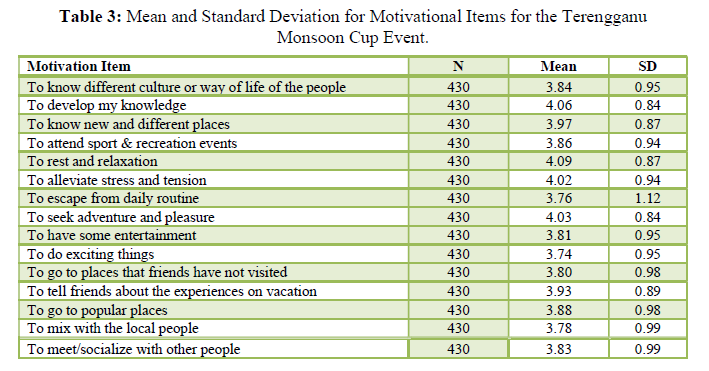
Based on Table 3 above, motivational items which scored above 3 in a 5-point scales (with 5.0 being extremely important), indicating that these attributes were deemed important to the respondents participating in the Terengganu Monsoon Cup event. Based on the fifteen motivational items extracted from the questionnaire, the motivational items examined indicated that the most important motivation for participating the event was wanted to rest and relaxation (M = 4.09), followed by wanted to develop knowledge (M = 4.06), to seek adventure and pleasure (M = 4.03), and to alleviate stress and tension (M = 4.02).
In relation to the event participation motives, the results in Table 4 seem to support that knowledge, relaxation, entertainment, prestige, and sociability were the motivating factors for the tourist participating in the Terengganu Monsoon Cup. Knowledge (M=3.96) and relaxation (M=3.95) factors were the most important motives, followed by prestige, knowledge and sociability factors as perceived by tourists who attended the event.
Visitors’ Satisfaction at the Malaysian Motorcycle Grand Prix
Site related features
As shown in Table 5 the visitors’ overall satisfaction of the site features was quite positive with recorded mean score 3.13 in a 5-point scales. In terms of overall percentage perception of respondents on site related features, about 10% were very satisfied, 21.9% were satisfied and about 43% rated as moderately satisfied. However, more than 20% of the respondents were not satisfied with overall features of the event’s site.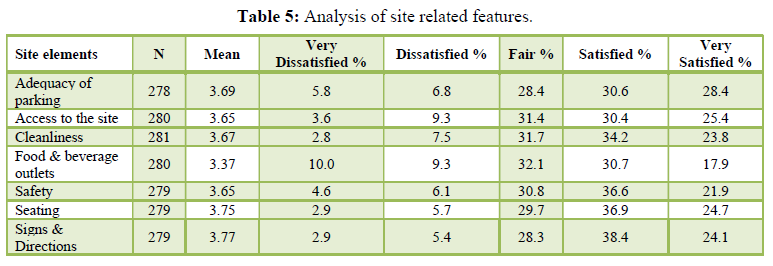

Based on the findings, about 30% of the respondents were either dissatisfied or very dissatisfied with most of the site elements surveyed such as, parking availability, accessibility to the site, cleanliness of the surrounding, lack of food and beverage outlets, availability of seat, signage to the site, and the condition of the toilet. Overall, most of the respondents were only moderately satisfied with all the site elements listed in the questionnaire.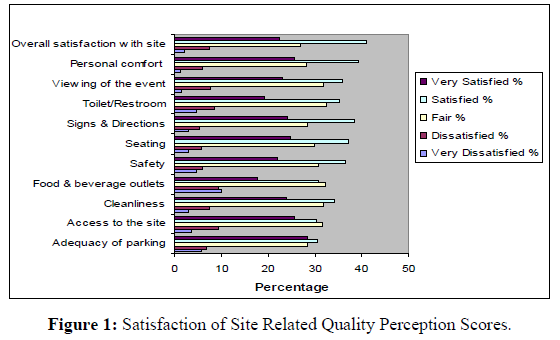
Staff related features
As shown in Table 6, the tourists’ overall satisfaction of the staff features was quite positive with recorded mean score 3.54 in a 5- point scales. In terms of overall percentage perception of respondents on staff related features, slightly more than 40% of the respondents were either very satisfied (12%) or satisfied (29.9%) and more than one third (39.2%) rated as moderately satisfied. However, slightly more than 10% of the respondents were not satisfied with overall features of the event’s staff (Figure 1).
Based on the findings, more than 40% of the respondents were either satisfied or very satisfied with most of the staff elements surveyed such as, helpfulness, knowledgeable, availability, presentable and appearance, and approachable attitude.
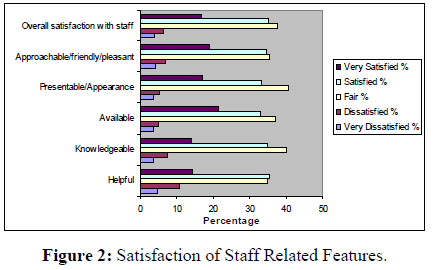
Other related features
The results in the Table 7 indicate that all the item of the other related elements being perceived by the respondents as above average with more than half (over 50%) were satisfied and very satisfied. About 27% of the respondents were very satisfied with the overall organization of the event (Figure 2).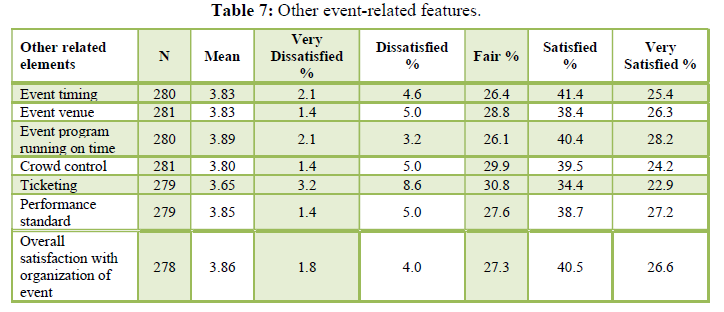

Visitor’ Satisfaction at the Terengganu Monsoon Cup
Site related features
As shown in Table 8, the tourists’ overall satisfaction of the site features was quite positive with recorded mean score 3.93 in a 5-point scales. In terms of overall percentage perception of respondents on site related features, about a quarter (26%) of the visitors were very satisfied, 46.3% were satisfied and about 24% rated as moderately satisfied. However, 3.5% of the respondents were not satisfied with overall features of the event’s site (Figure 3).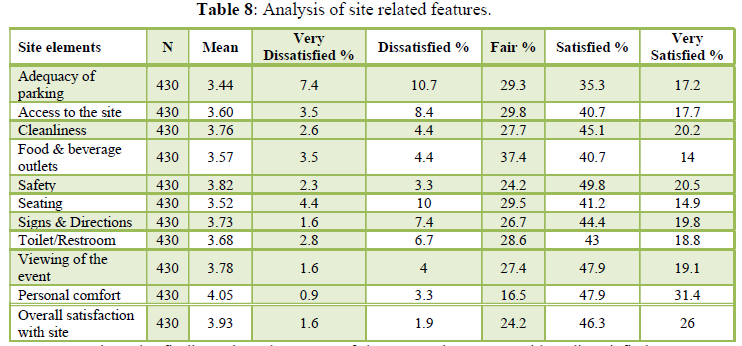
Based on the findings, less than 10% of the respondents were either dissatisfied or very dissatisfied with most of the site elements surveyed except for parking availability, accessibility to the site and seating availability slightly more than 10%. Overall, the vast majority of respondents were satisfied with all the site elements listed in the questionnaire.
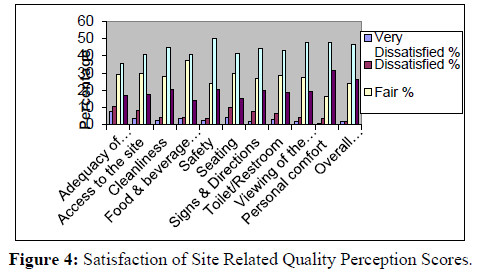
Staff related features
As shown in Table 9, the tourists’ overall satisfaction of the staff features was quite positive with recorded mean score 3.67 in a 5- point scales. In terms of overall percentage perception of respondents on staff related features, slightly more than 60% of the respondents were very satisfied (14.4%) and satisfied (46.7%). However, only slightly more than 5% of the respondents were not satisfied with overall features of the event’s staff (Figure 4).
Based on the findings, more than 50% of the respondents were either satisfied and very satisfied with most of the staff elements features such as, helpfulness, knowledgeable, availability, presentable and appearance, and approachable attitude.
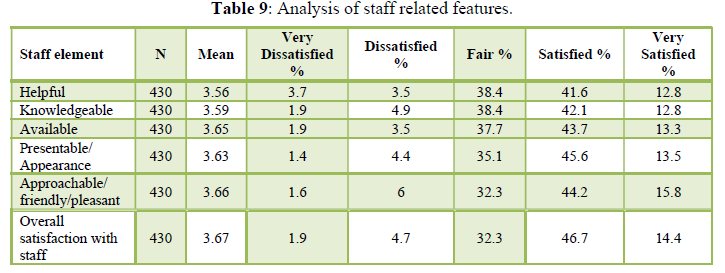
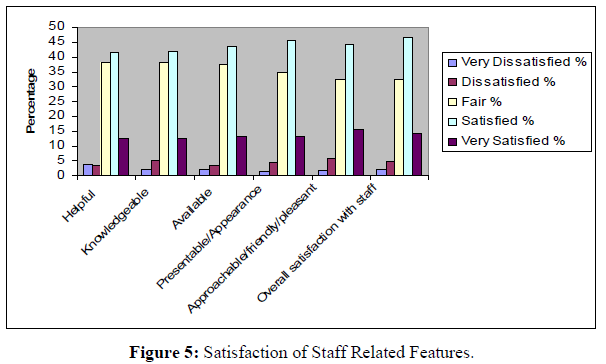
Other related features
The results in the Table 10 indicate that all the items of the other related elements being perceived by the respondents as positive with more than 60% were satisfied and very satisfied. About 20% of the respondents were very satisfied with the overall organization of the event. (Figure 5).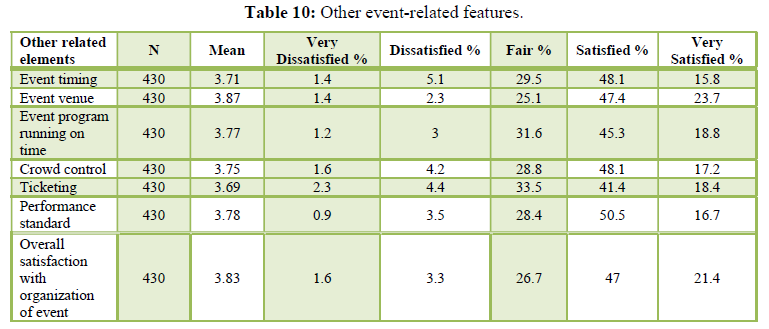
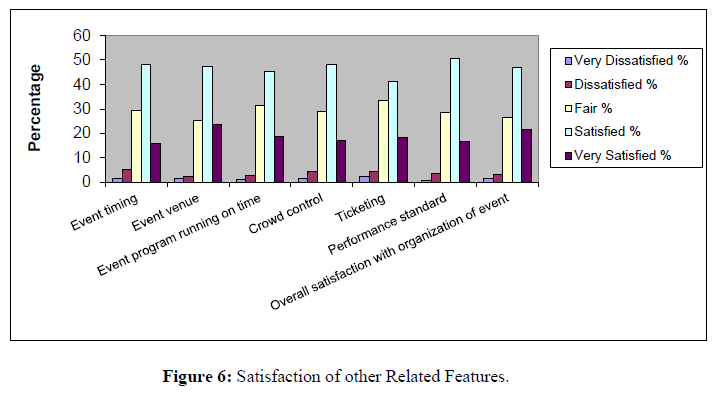
DISCUSSION
Therefore, it is clear that all five motivating factors for tourists’ participation in both events, namely knowledge, sociability, relaxation, entertainment, and prestige yield significant data. Hence, it highlighted the importance of these factors in influencing visitors’ decision to attend the events (Egresi & Kara, 2014). As seen from the Moto GP event, entertainment is the main motivating factor for visitors’ who attended the event. The results in line with Kim et al., (2013) who concluded that visitors’ attending a mega-sporting event mainly for entertainment purpose. On the other hand, knowledge is the main motivating factor for visitors who attended the Monsoon Cup. Thus, it proves that this type of event has been accepted as one of the sport events that visitors can learn something with their family and friends. Although the sociability factor yields the lowest mean for both events, the overall mean still shows significant result, thus making it an important factor too in determining visitors’ participation. It is supported by Prayag and Grivel (2014) who found out that sociability is one of the main motive of visitors to attend a sport event. However, based on the motivating factors listed, it can be concluded that visitors have multiple motives to attend both events rather than a single motive (Cassidy, 2005) (Figure 6).
In terms of overall satisfaction, both events’ visitors seem satisfied with overall site related features, staff, and other event-related features. An in-depth comparison of the site-related features have shown that visitors at the MotoGP event were moderately satisfied whereas visitors of the Monsoon Cup are satisfied. Hence, the findings suggested that several basic site-related features needed more attention particularly in the aspects such as food and beverage, toilet, parking availability, cleanliness, and site accessibility as those are considered essential needs by tourist when evaluating a certain event. Therefore, it is clear that most of the site features require improvement during future organization of the event.
Furthermore, the result from both events indicated that the respondents are perceived to be more satisfied than dissatisfied towards the staff-related features. Thus, the result is in line with Markovic (2019) who identified that staff service quality is one of the strongest significant impacts on visitors’ satisfaction. No doubt, the services provided by staff and largely depends on their knowledge, skills, appearance and behavior towards tourists (Peric, et al., 2018). Hence, the findings certainly proved that the staffs and personnel are trained professionally and able to do their respective duties accordingly. On the other hand, both events have garnered an above average level of satisfaction in terms of other event-related quality in relation to the event timing, venue, crowd, and others. Thus, it explained the importance of proper timing, venue, and convenience and accessibility of the event which will lead to higher overall visitors’ satisfaction.
CONCLUSION
In conclusion, an event can be a strong marketing and promotional tool, particularly for the organizer and marketer of the event. Thus, the findings showed that all the five motivating factors, namely knowledge, sociability, relaxation, entertainment, and prestige are significant in determining tourists’ participation in both events. Comparatively, the main motivational factor to participate in the Malaysian Motorcycle Grand Prix is for entertainment purpose whereas knowledge is the main factor for visitors to participate in the Monsoon Cup. In terms of satisfaction, visitors were satisfied with overall site related features, staff, and other event-related features for both events. In addition, the findings of the survey indicated that there is moderate satisfaction towards the site-related features, but visitors were satisfied with the staffs’ presentable appearance, friendliness, and approachable attitude. Therefore, the findings revealed important aspects to be taken into consideration in relation to event planning and tourism promotion. Hence, the insights gathered from this research will eventually assist event marketers and managers in determining what motivates visitors to attend an event and, at the same time, meeting their requirements.
Nevertheless, the limitation of this study is in terms of the generalizability of the research findings. As the questionnaire was completed by sport tourists who attended the two events stated in this study, they may not be a representation of the whole population of the study. As a result, the findings are prone to bias. Additionally, this study collected data on event visitors without determining if they were first-time visitors, repeat visitor, domestic visitors, international visitors. Therefore, future research can take into account the limitations of the study in term of the sampling strategies used and also the type of visitors. On the other hand, this study also recommends the use of modification measuring scales to acquire qualitative data that may be utilised to explicitly describe visitors' motivations and satisfaction.
- Aicher, T. & Brenner, J. (2015). Individuals’ motivation to participate in sport tourism: A Self-Determination theory perspective. International Journal of Sport Management Recreation & Tourism, 18(d), 56-81. DOI: 10.5199/ijsmart-1791-874X-18d
- Aicher, T., Karadakis, K. & Eddosary, M. M. (2015). Comparison of sport tourists’ and locals’ motivation to participate in a running event. International Journal of Event and Festival Management, 6(3), 215-234. DOI: https://doi.org/10.1108/IJEFM-03-2015-0011
- Beerli, A., & Martin, J. D. (2004). Tourists’ characteristics and the perceived image of tourist destinations: A quantitative analysis – a case study of Lanzarote, Spain. Tourism Management, 25(5), 623-636. DOI: 10.1016/j.tourman.2003.06.004
- Cassidy, F. (2005). What motivates sports event tourists: a synthesis of three disciplines. In: Women in Research Conference 2005: Women Doing research, 24-25 Nov 2005, Gladstone, Australia.
- Dolinting, E. E., Yusof, A. & Chee, C. S. (2013). Understanding sport tourists' motives and perceptions of Sabah, Malaysia as a sport tourist destination. Journal of Physical Education and Sport, 13(4), 547-556. DOI: 10.7752/jpes.2013.04086
- Egresi, I., & Kara, F. (2014). Motives of tourists attending small-scale events: The case of three local festival and events in Istanbul, Turkey. GeoJournal of Tourism and Geosites, 14(2), 93–110.
- Fodness, D. (1994). Measuring tourist motivation. Annals of Tourism Research, 21, 555-581. https://doi.org/10.1016/0160-7383(94)90120-1
- Fuchs, M. & Weiermair, K. (2004). Destination Benchmarking: An Indicator-System’s Potential for Exploring Guest Satisfaction. Journal of Travel Research, 42(3), 212-225. DOI: 10.1177/0047287503258827
- Funk, D. C., Beaton, A., & Alexandris, K. (2012). Sport consumer motivation: Autonomy and control orientations that regulate fan behaviours. Sport Management Review, 15(3), 355–367. https://doi.org/10.1016/j.smr.2011.11.001
- Funk, D. C., Alexandris, K., & Ping, Y. (2009). To go or to stay home and watch: Exploring the balance between motives and perceived constraints for major events: A case study of the 2008 Beijing Olympic Games, International Journal of Tourism Research, 11(1), 41-53.
- Gibson, H. J., Kaplanidou, K., & Kang, S. J. (2012). Small-scale event sport tourism: A case study in sustainable tourism. Sport Management Review, 15(2), 160–170. DOI: 10.1016/j.smr.2011.08.013
- Grace, D., & O’Cass, A. (2004). Examining service experiences and post-consumption evaluations. Journal of Services Marketing, 18(6), 450–461. DOI: 10.1108/08876040410557230
- Higham, J. (Ed.) (2005). Sport tourism destination: issues, opportunities and analysis. Oxford: Elsevier Butterworth-Heinemann. ISBN: 9780080474434
- Kaplanidou, K. & Gibson, H. J. (2010). Predicting behavioral intentions of active event sport tourists: The case of a small-scale recurring sports event. Journal of Sport Tourism, 15(2), 163-179. DOI: 10.1080/14775085.2010.498261
- Kaplanidou, K. & Vogt, C. A. (2007). The Interrelationship between Sport Event and Destination Image and Sport Tourists' Behaviours. Journal of Sport Tourism, 12(3), 183-206. DOI: 10.1080/14775080701736932
- Kim, S. K., Byon, K. K., Yu, J.-G., Zhang, J. J., & Kim, C. (2013). Social motivations and consumption behavior of spectators attending a Formula One Motor-Racing Event. Social Behavior and Personality, 41(8), 1359–1378. DOI: 10.2224/sbp.2013.41.8.1359
- Kim, Y. H., Kim, M., Ruetzler, T., & Taylor, J. (2010). An examination of festival attendees’ behavior using SEM. International Journal of Event and Festival Management, 1(1), 86–95. DOI: 10.1108/17852951011029324
- Ko, Y. J., Kim, Y. K., Kim, M. K., & Lee, J. H. (2010). The role of involvement and identification on event quality perceptions and satisfaction a case of US Taekwondo Open. Asia Pacific Journal of Marketing and Logistics, 22(1), 25–39. DOI: 10.1108/13555851011013137
- Krohn, B. D., & Backman, S. J. (2011). Event attributes and the structure of satisfaction: A case study of golf spectators. Event Management, 15(3), 267–277. DOI: 10.3727/152599511X13124625650629
- Lee, J. & Beeler, C. (2009). An investigation of predictors of satisfaction and future intention: links to motivation, involvement, and service quality in a local festival. Event Management, 13(1), 17-29. DOI: 10.3727/152599509789130584
- Markovic, S. (2019). How festival experience quality influence visitor satisfaction? A quantitative approach. Naše gospodarstvo/Our Economy, 65(4), 47–56. DOI: 10.2478/ ngoe-2019-0019
- McCartney, G. (2010). Event Management: An Asian perspective. Singapore: McGraw-Hill. ISBN: 9789814731775
- Neill, M. O., Carlsen, J., & Getz, D. (1999). Case studies evaluation of service quality at events: the 1998 Coca-Cola Masters Surfing event at Margaret River, Western Australia. Managing Service Quality, 9(3), 158–166. https://doi.org/10.1108/09604529910267064
- Nicholson, R. E., & Pearce, D.G. (2001). Why do people attend events: A comparative analysis of visitor motivations at four South Island events. Journal of Travel Research, 39(4), 449-461. https://doi.org/10.1177/004728750103900412
- Pearce, P. L. (2005). Tourist behaviour: Themes and conceptual schemes. Clevedon: Channel View Publication. ISBN: 9781845410247
- Peric, G., Gasic, M., Stojiljkovic, M. & Nesic, I. (2018). The impact of employee satisfaction on the tourist satisfaction with the services of spa tourism. Konomika Poljoprivrede, 66(2), 617-632. DOI: 10.5937/ekoPolj1802617P
- Prayag, G., & Grivel, E. (2014). Motivation, satisfaction, and behavioral intentions: Segmenting youth participants at the Interamnia World Cup 2012. Sport Marketing Quarterly, 23(3), 148–160.
- Ramírez-hurtado, J. M. (2014). Assessing motivation and satisfaction in an emerging kind of sports tourism: Paddle tennis. Enlightening Tourism. A Pathmaking Journal, 4(2), 168–194.
- Standeven, J., & De Knop, P. (1999). Sport tourism. Champaign, IL: Human Kinetics. ISBN: 978-0873228534
- Tzetzis, G., Alexandris, K., and Kapsampeli, S. (2014). Predicting visitors’ satisfaction and behavioral intentions from service quality in the context of a small-scale outdoor sport event. International Journal of Event and Festival Management, 5(1), 4–21. DOI: 10.1108/IJEFM-04-2013-0006
- Wann, D. L., Grieve, F. G., Zapalac, R. K., & Pease, D. G. (2008). Motivational profiles of sport fans of different sports. Sport Marketing Quarterly, 17, 6-19.
- Yusof, A., Omar-Fauzee, M. S., Shah, P. M., & Geok, S. K. (2009). Exploring small-scale sport event tourism in Malaysia. Research Journal of International Studies, 9, 47–58.
- Zarei, A. & Yusof, A. (2014). Informational sources of sport tourists attending ISTAF super series. Journal of Physical Education and Sport, 14(4), 554-561. DOI: 10.7752/jpes.2014.04086







